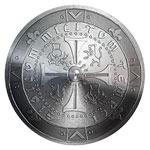Grail

The Grail is a great secret and mystery legacy, the symbol of transformation. Is the Grail a crystal symbolizing the source of immortality, the cup Jesus drank from at the Secret Supper, the container where Joseph of Arimathea collected the blood of Jesus or an all-bearing cauldron? Or perhaps a sacrificial cup, a drink of ambrosia, or an obtained Philosopher’s stone? The hypotheses we can list are innumerable and they all correspond to the concept of the Grail. One thing however is clear: this is a true mystery, which hides the secret of transformation and urges millions of people to search for the knowledge of higher perfection.
The sources of the Holy Grail knowledge lead us back to, first of all, Egyptian Hermeticism and Celtic symbolism, whose knowledge was later inherited and revealed in the Christian tradition. By its nature and qualities the Grail corresponds to the emerald, which represents the highest properties and links in our body or directly the link of the blood with three-dimensional space.
Nevertheless, the image of the Grail is above all that of the quest, the pursuit of perfection. Interestingly enough, the quest for the Grail merged with the concept of knighthood, thus essentially forming the special status of the knight not only as a warrior or an adventurer but also as a person endowed with mystery, often combined with a dramatic flare.
The legends of the Grail emerged in the Middle Ages as a part of the Arthurian legends. In the 12th century the Grail seekers were Perceval, Gawain, Lancelot, Bors, Galahad - the knights of King Arthur. The name Grail itself originates from the Old French word graal referring to a large dish or tray. This was actually the form of the perfect container described in the oldest of the preserved texts of the Grail: the novel of Chretien de Troyes ‘Perceval, or The Story of the Grail’ (c. 1182). In the novel the Grail is described as a large container inlaid with precious stones. Other poems and novels interpret the unusual word ‘Grail’ as a cup, a goblet or even a stone. An equally interesting conceptualization of the Grail presents it as a key to the crystal temple or even to the Celtic Shambhala, Avalon.
Anyway, the area of influence of the Grail intersects with the Celtic territories: Montségur and Oléron in France, Mont Salvage in the Pyrenees, the Brocéliande forest, Salisbury and Glastonbury in England, Corwen in Wales, the island of Iona and the Palace of Holyroodhouse in Scotland.
The Grail, in fact, represents also a form of movement, which is linked to Avalon and has four directions. The most important fact here, however, is that the immediate center of the Grail is Glastonbury where it turns into a sort of key for the passage to Avalon.
 |
 |
 |
 | |
| ORDER THE BOOKS TEMPLAR. MEASURE and TEMPLAR. RITUAL | TAKE PART IN THE TOUR RITUAL – THE NORTH ERN CORNER OF AVALON |
17 march 2014

